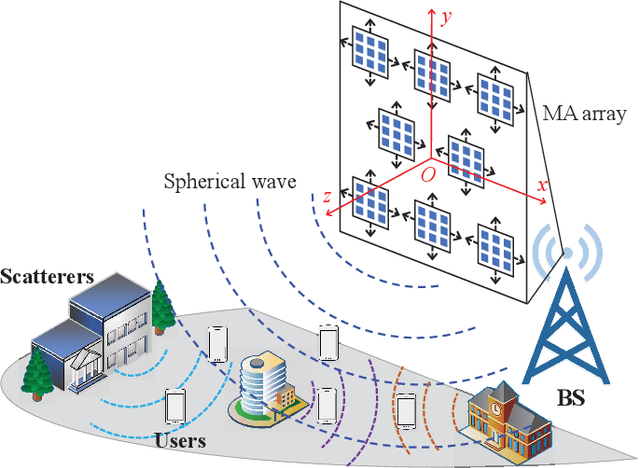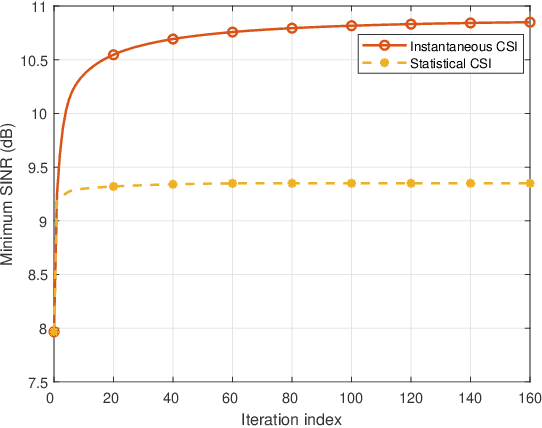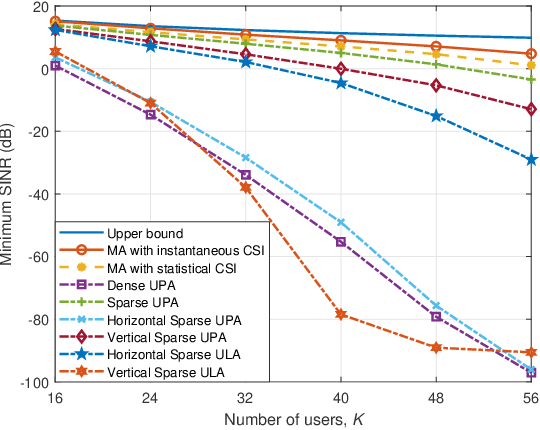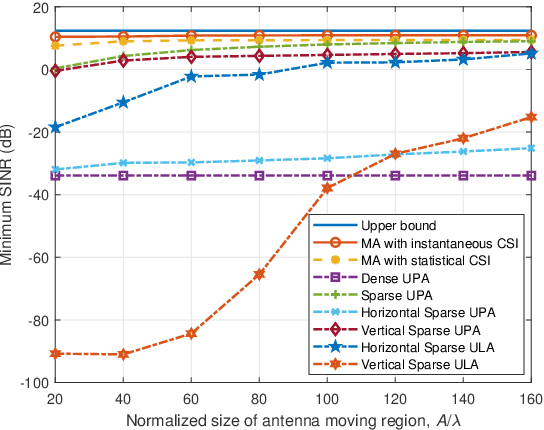Wenyan Ma
AI Signal Processing Paradigm for Movable Antenna: From Geometric Optimization to Electromagnetic Reconfigurability
Oct 22, 2025Abstract:As 6G wireless communication systems evolve toward intelligence and high reconfigurability, the limitations of traditional fixed antenna (TFA) has become increasingly prominent, with geometrically movable antenna (GMA) and electromagnetically reconfigurable antenna (ERA) emerging as key technologies to break through this bottleneck. GMA activates spatial degrees of freedom (DoF) by dynamically adjusting antenna positions, ERA regulates radiation characteristics using tunable metamaterials, thereby introducing DoF in the electromagnetic domain. However, the ``geometric-electromagnetic dual reconfiguration" paradigm formed by their integration poses severe challenges of high-dimensional hybrid optimization to signal processing. To address this issue, we integrate the geometric optimization of GMA and the electromagnetic reconfiguration of ERA for the first time, propose a unified modeling framework for movable and reconfigurable antenna (MARA), investigate the channel modeling and spectral efficiency (SE) optimization for GMA, ERA, and MARA. Besides, we systematically review artificial intelligence (AI)-based solutions, focusing on analyzing the advantages of AI over traditional algorithms in high-dimensional non-convex optimization computations. This paper fills the gap in existing literature regarding the lack of a comprehensive review on the AI-driven signal processing paradigm under geometric-electromagnetic dual reconfiguration and provides theoretical support for the design and optimization of 6G wireless systems with high SE and flexibility.
Movable-Antenna Trajectory Optimization for Wireless Sensing: CRB Scaling Laws over Time and Space
Sep 18, 2025Abstract:In this paper, we present a new wireless sensing system utilizing a movable antenna (MA) that continuously moves and receives sensing signals to enhance sensing performance over the conventional fixed-position antenna (FPA) sensing. We show that the angle estimation performance is fundamentally determined by the MA trajectory, and derive the Cramer-Rao bound (CRB) of the mean square error (MSE) for angle-of-arrival (AoA) estimation as a function of the trajectory for both one-dimensional (1D) and two-dimensional (2D) antenna movement. For the 1D case, a globally optimal trajectory that minimizes the CRB is derived in closed form. Notably, the resulting CRB decreases cubically with sensing time in the time-constrained regime, whereas it decreases linearly with sensing time and quadratically with the movement line segment's length in the space-constrained regime. For the 2D case, we aim to achieve the minimum of maximum (min-max) CRBs of estimation MSE for the two AoAs with respect to the horizontal and vertical axes. To this end, we design an efficient alternating optimization algorithm that iteratively updates the MA's horizontal or vertical coordinates with the other being fixed, yielding a locally optimal trajectory. Numerical results show that the proposed 1D/2D MA-based sensing schemes significantly reduce both the CRB and actual AoA estimation MSE compared to conventional FPA-based sensing with uniform linear/planar arrays (ULAs/UPAs) as well as various benchmark MA trajectories. Moreover, it is revealed that the steering vectors of our designed 1D/2D MA trajectories have low correlation in the angular domain, thereby effectively increasing the angular resolution for achieving higher AoA estimation accuracy.
A Tutorial on Movable Antennas for Wireless Networks
Feb 25, 2025



Abstract:Movable antenna (MA) has been recognized as a promising technology to enhance the performance of wireless communication and sensing by enabling antenna movement. Such a significant paradigm shift from conventional fixed antennas (FAs) to MAs offers tremendous new opportunities towards realizing more versatile, adaptive and efficient next-generation wireless networks such as 6G. In this paper, we provide a comprehensive tutorial on the fundamentals and advancements in the area of MA-empowered wireless networks. First, we overview the historical development and contemporary applications of MA technologies. Next, to characterize the continuous variation in wireless channels with respect to antenna position and/or orientation, we present new field-response channel models tailored for MAs, which are applicable to narrowband and wideband systems as well as far-field and near-field propagation conditions. Subsequently, we review the state-of-the-art architectures for implementing MAs and discuss their practical constraints. A general optimization framework is then formulated to fully exploit the spatial degrees of freedom (DoFs) in antenna movement for performance enhancement in wireless systems. In particular, we delve into two major design issues for MA systems. First, we address the intricate antenna movement optimization problem for various communication and/or sensing systems to maximize the performance gains achievable by MAs. Second, we deal with the challenging channel acquisition issue in MA systems for reconstructing the channel mapping between arbitrary antenna positions inside the transmitter and receiver regions. Moreover, we show existing prototypes developed for MA-aided communication/sensing and the experimental results based on them. Finally, the extension of MA design to other wireless systems and its synergy with other emerging wireless technologies are discussed.
Movable Antenna Enhanced Integrated Sensing and Communication Via Antenna Position Optimization
Jan 14, 2025Abstract:In this paper, we propose an integrated sensing and communication (ISAC) system aided by the movable-antenna (MA) array, which can improve the communication and sensing performance via flexible antenna movement over conventional fixed-position antenna (FPA) array. First, we consider the downlink multiuser communication, where each user is randomly distributed within a given three-dimensional zone with local movement. To reduce the overhead of frequent antenna movement, the antenna position vector (APV) is designed based on users' statistical channel state information (CSI), so that the antennas only need to be moved in a large timescale. Then, for target sensing, the Cramer-Rao bounds (CRBs) of the estimation mean square error for different spatial angles of arrival (AoAs) are derived as functions of MAs' positions. Based on the above, we formulate an optimization problem to maximize the expected minimum achievable rate among all communication users, with given constraints on the maximum acceptable CRB thresholds for target sensing. An alternating optimization algorithm is proposed to iteratively optimize one of the horizontal and vertical APVs of the MA array with the other being fixed. Numerical results demonstrate that our proposed MA arrays can significantly enlarge the trade-off region between communication and sensing performance compared to conventional FPA arrays with different inter-antenna spacing. It is also revealed that the steering vectors of the designed MA arrays exhibit low correlation in the angular domain, thus effectively reducing channel correlation among communication users to enhance their achievable rates, while alleviating ambiguity in target angle estimation to achieve improved sensing accuracy.
Movable Antenna Enabled Near-Field Communications: Channel Modeling and Performance Optimization
Sep 28, 2024



Abstract:Movable antenna (MA) technology offers promising potential to enhance wireless communication by allowing flexible antenna movement. To maximize spatial degrees of freedom (DoFs), larger movable regions are required, which may render the conventional far-field assumption for channels between transceivers invalid. In light of it, we investigate in this paper MA-enabled near-field communications, where a base station (BS) with multiple movable subarrays serves multiple users, each equipped with a fixed-position antenna (FPA). First, we extend the field response channel model for MA systems to the near-field propagation scenario. Next, we examine MA-aided multiuser communication systems under both digital and analog beamforming architectures. For digital beamforming, spatial division multiple access (SDMA) is utilized, where an upper bound on the minimum signal-to-interference-plus-noise ratio (SINR) across users is derived in closed form. A low-complexity algorithm based on zero-forcing (ZF) is then proposed to jointly optimize the antenna position vector (APV) and digital beamforming matrix (DBFM) to approach this bound. For analog beamforming, orthogonal frequency division multiple access (OFDMA) is employed, and an upper bound on the minimum signal-to-noise ratio (SNR) among users is derived. An alternating optimization (AO) algorithm is proposed to iteratively optimize the APV, analog beamforming vector (ABFV), and power allocation until convergence. For both architectures, we further explore MA design strategies based on statistical channel state information (CSI), with the APV updated less frequently to reduce the antenna movement overhead. Simulation results demonstrate that our proposed algorithms achieve performance close to the derived bounds and also outperform the benchmark schemes using dense or sparse arrays with FPAs.
Movable Antenna Enhanced Wireless Sensing Via Antenna Position Optimization
May 02, 2024Abstract:In this paper, we propose a new wireless sensing system equipped with the movable-antenna (MA) array, which can flexibly adjust the positions of antenna elements for improving the sensing performance over conventional antenna arrays with fixed-position antennas (FPAs). First, we show that the angle estimation performance in wireless sensing is fundamentally determined by the array geometry, where the Cramer-Rao bound (CRB) of the mean square error (MSE) for angle of arrival (AoA) estimation is derived as a function of the antennas' positions for both one-dimensional (1D) and two-dimensional (2D) MA arrays. Then, for the case of 1D MA array, we obtain a globally optimal solution for the MAs' positions in closed form to minimize the CRB of AoA estimation MSE. While in the case of 2D MA array, we aim to achieve the minimum of maximum (min-max) CRBs of estimation MSE for the two AoAs with respect to the horizontal and vertical axes, respectively. In particular, for the special case of circular antenna movement region, an optimal solution for the MAs' positions is derived under certain numbers of MAs and circle radii. Thereby, both the lower- and upper-bounds of the min-max CRB are obtained for the antenna movement region with arbitrary shapes. Moreover, we develop an efficient alternating optimization algorithm to obtain a locally optimal solution for MAs' positions by iteratively optimizing one between their horizontal and vertical coordinates with the other being fixed. Numerical results demonstrate that our proposed 1D/2D MA arrays can significantly decrease the CRB of AoA estimation MSE as well as the actual MSE compared to conventional uniform linear arrays (ULAs)/uniform planar arrays (UPAs) with different values of uniform inter-antenna spacing.
Dynamic Beam Coverage for Satellite Communications Aided by Movable-Antenna Array
Apr 24, 2024



Abstract:Due to the ultra-dense constellation, efficient beam coverage and interference mitigation are crucial to low-earth orbit (LEO) satellite communication systems, while the conventional directional antennas and fixed-position antenna (FPA) arrays both have limited degrees of freedom (DoFs) in beamforming to adapt to the time-varying coverage requirement of terrestrial users. To address this challenge, we propose in this paper utilizing movable antenna (MA) arrays to enhance the satellite beam coverage and interference mitigation. Specifically, given the satellite orbit and the coverage requirement within a specific time interval, the antenna position vector (APV) and antenna weight vector (AWV) of the satellite-mounted MA array are jointly optimized over time to minimize the average signal leakage power to the interference area of the satellite, subject to the constraints of the minimum beamforming gain over the coverage area, the continuous movement of MAs, and the constant modulus of AWV. The corresponding continuous-time decision process for the APV and AWV is first transformed into a more tractable discrete-time optimization problem. Then, an alternating optimization (AO)-based algorithm is developed by iteratively optimizing the APV and AWV, where the successive convex approximation (SCA) technique is utilized to obtain locally optimal solutions during the iterations. Moreover, to further reduce the antenna movement overhead, a low-complexity MA scheme is proposed by using an optimized common APV over all time slots. Simulation results validate that the proposed MA array-aided beam coverage schemes can significantly decrease the interference leakage of the satellite compared to conventional FPA-based schemes, while the low-complexity MA scheme can achieve a performance comparable to the continuous-movement scheme.
Performance Analysis and Optimization for Movable Antenna Aided Wideband Communications
Jan 17, 2024Abstract:Movable antenna (MA) has emerged as a promising technology to enhance wireless communication performance by enabling the local movement of antennas at the transmitter (Tx) and/or receiver (Rx) for achieving more favorable channel conditions. As the existing studies on MA-aided wireless communications have mainly considered narrow-band transmission in flat fading channels, we investigate in this paper the MA-aided wideband communications employing orthogonal frequency division multiplexing (OFDM) in frequency-selective fading channels. Under the general multi-tap field-response channel model, the wireless channel variations in both space and frequency are characterized with different positions of the MAs. Unlike the narrow-band transmission where the optimal MA position at the Tx/Rx simply maximizes the single-tap channel amplitude, the MA position in the wideband case needs to balance the amplitudes and phases over multiple channel taps in order to maximize the OFDM transmission rate over multiple frequency subcarriers. First, we derive an upper bound on the OFDM achievable rate in closed form when the size of the Tx/Rx region for antenna movement is arbitrarily large. Next, we develop a parallel greedy ascent (PGA) algorithm to obtain locally optimal solutions to the MAs' positions for OFDM rate maximization subject to finite-size Tx/Rx regions. To reduce computational complexity, a simplified PGA algorithm is also provided to optimize the MAs' positions more efficiently. Simulation results demonstrate that the proposed PGA algorithms can approach the OFDM rate upper bound closely with the increase of Tx/Rx region sizes and outperform conventional systems with fixed-position antennas (FPAs) under the wideband channel setup.
Multi-Beam Forming with Movable-Antenna Array
Nov 07, 2023Abstract:Conventional multi-beam forming with fixed-position antenna (FPA) arrays needs to trade-off between maximizing the beamforming gain over desired directions and minimizing the interference power over undesired directions. In this letter, we study the enhanced multi-beam forming with a linear movable-antenna (MA) array by exploiting the new degrees of freedom (DoFs) via antennas' position optimization. Specifically, we jointly optimize the antenna position vector (APV) and antenna weight vector (AWV) to maximize the minimum beamforming gain over multiple desired directions, subject to a given constraint on the maximum interference power over undesired directions. We propose an efficient alternating optimization algorithm to find a suboptimal solution by iteratively optimizing one of the APV and AWV with the other being fixed. Numerical results show that the proposed multi-beam forming design with MA arrays can significantly outperform that with the traditional FPA arrays and other benchmark schemes in terms of both beamforming gain and interference suppression.
Movable-Antenna Array Enhanced Beamforming: Achieving Full Array Gain with Null Steering
Aug 17, 2023Abstract:Conventional beamforming with fixed-position antenna (FPA) arrays has a fundamental trade-off between maximizing the signal power (array gain) over a desired direction and simultaneously minimizing the interference power over undesired directions. To overcome this limitation, this letter investigates the movable antenna (MA) array enhanced beamforming by exploiting the new degree of freedom (DoF) via antenna position optimization, in addition to the design of antenna weights. We show that by jointly optimizing the antenna positions vector (APV) and antenna weights vector (AWV) of a linear MA array, the full array gain can be achieved over the desired direction while null steering can be realized over all undesired directions, under certain numbers of MAs and null-steering directions. The optimal solutions for AWV and APV are derived in closed form, which reveal that the optimal AWV for MA arrays requires only the signal phase adjustment with a fixed amplitude. Numerical results validate our analytical solutions for MA array beamforming and show their superior performance to the conventional beamforming techniques with FPA arrays.
 Add to Chrome
Add to Chrome Add to Firefox
Add to Firefox Add to Edge
Add to Edge